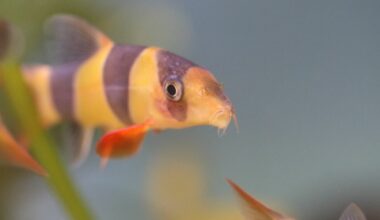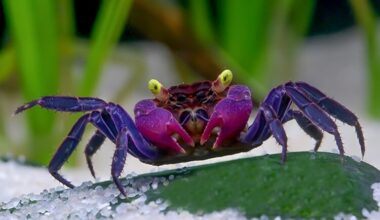Welcome to our Blue Devil Damselfish care guide! If you’re a saltwater aquarist looking to add a splash of vibrant blue to your tank, you’re in for a treat. These striking fish, known as Blue Devil Damselfish, can bring a lively and captivating presence to any marine setup.
In this guide, we’ll share our knowledge and insights to help you provide the best care for your Blue Devil Damselfish. From their preferred habitat and feeding habits to their unique behaviors and tank compatibility, we’ll cover everything you need to know.
Whether you’re a seasoned hobbyist or new to the world of marine aquariums, we’re here to assist you in creating a thriving and harmonious environment for these captivating creatures.
Let’s dive in and explore the fascinating world of Blue Devil Damselfish together!
Table of Contents
Species Summary
The Blue Devil Damselfish is known as the blue damselfish, blue demoiselle and South Sea demoiselle. Its scientific name is Chrysiptera cyanea, and it comes from the Pomacentridae family. They can be found around the Indo-West Pacific, including Western Australia, the Great Barrier Reef and the Ryukyu Islands.
They are mid-to-bottom dwellers, and their natural habitat is made up of rubble and coral. Furthermore, they enjoy hiding near protected lagoons and subtidal coral reef flats. A frightened damselfish even hides in a crevice for safety.
Author Note: Despite their behavior when afraid, these fish are territorial and aggressive with certain other fish.
Moreover, the Blue Devil Damselfish is a resilient species that can hold its own against certain species and illnesses. As for their tanks, they strive in saltwater conditions. They can also be placed in a fish or reef aquarium to co-exist with carefully chosen tankmates.
Appearance
The Blue Devil Damselfish is a small and unique fish. Its bright blue body sticks out in its tank, and its bold color scheme is the reason this fish is so popular among aquarists. The snout and tail of the male fish are yellow, while a black spot can be found on the dorsal fins of female and juvenile fish.

Lifespan
The average lifespan of the Blue Devil Damselfish is two to six years. In captivity, the fish can live for up to 15 years with the proper care.
Average Size
The average size of the Blue Devil Damselfish is 2.8 inches, but it can grow up to 3.4 inches. It is one of the smallest fish you can add to your aquarium.
Blue Devil Damselfish Care
As mentioned earlier, the Blue Devil Damselfish is a good fish for beginners because it is easy to take care of them. Additionally, these fish adapt well to captivity, so they do not need special care to get used to their aquarium.
It is still important to ensure your fish receives proper care, and you can start by providing a comfortable, liveable environment for them. This ranges from supplying a suitable tank size to creating the right water parameters.
Tank Size
It is recommended to provide a minimum tank size of 20 to 30 gallons for a single or pair of Blue Devil Damselfish. If you are housing more than two fish, it is best to provide a 55-gallon tank. This way, your fish have enough space to live together comfortably.
Water Parameters
Providing the right water parameters is essential for more than just creating a comfortable atmosphere. You also need the right water parameters for breeding purposes.
Water temperature: 72 to 84 degrees Fahrenheit (22.2 to 28.9 degrees Celsius)
pH levels: 8.1-8.4.
Water hardness: 8-12 dKH.
Specific gravity: 1.020-1.025.
Tank Setup
You can easily keep your damselfish in a well-kept tank with bi-weekly or monthly water changes. This is important to provide a clean environment and a nutrient source which is why we included the guidelines below to help you determine how much water, and how often you need to change it depending on the type and size of your aquarium.
Fish Only Tanks
- Nano and Small Tanks of Up to 40 Gallons: 10 percent bi-weekly or 20 percent monthly water changes.
- Medium Tanks of Up to 90 Gallons: 15 percent bi-weekly water changes.
- Large Tanks of 100 Gallons or More: Depending on the bioload in the tank, you can change the water 10 percent bi-weekly or 20 percent monthly. However, you need to wait until the water is older and stable.
Reef Tanks
- Nano and Small Tanks of Up to 40 Gallons: 15 percent bi-weekly water changes.
- Medium Tanks of Up to 90 Gallons: 20 percent to 30 percent monthly, based on the bioload.
- Large Tanks of 100 Gallons or More: 20 percent to 30 percent every six weeks, based on the bioload. Once again, you must wait until the water is older and stable.
Are Blue Devil Damselfish Reef-Safe?
The Blue Devil Damselfish is reef-safe, so you do not have to worry about your fish disturbing your coral and invertebrates. Furthermore, you can rest assured your fish is safe inside a reef aquarium.
Common Possible Diseases & Prevention
The biggest problem for a Blue Devil Damselfish is stress while shipping. However, there have been documents of these damselfish dying suddenly. When this happens, it is possible they have caught a common disease from other saltwater fish. Luckily, the Blue Devil Damselfish is a tough fish, so this is a rare occurrence.
While it is uncommon for the Blue Devil Damselfish to fall ill, they are still susceptible to parasites such as Crypt, Marine Velvet and Uronema disease. The good news is, all these parasites are treatable if caught early.
Of all the diseases, the one relatively easy to cure is Crypt or salt water ich. Marine Velvet on the other hand, needs to be addressed quickly since only a few fish have been identified to be able to generate a natural and sometimes temporary immunity to this disease. Moreover, if you find your fish with lack of appetite it could be the Uronema disease which is quite deadly.
Author Note: One way to treat illnesses is with live foods, such as worms, fish and shrimp and make sure to always properly clean and quarantine items before adding them to the tank.
Food & Diet
The Blue Devil Damselfish are Omnivores, and their diet consists of both meat and vegetables. They enjoy feasting on a range of food, including algae, fish eggs, brine shrimp and worms. You can feed them both frozen and live foods, but live food is not a required source of nutrition.
In addition, some damselfish accept flakes and pellets, but you need to use tank water to wet the pellets before their feeding. Otherwise, air from the pellets may get inside your fish’s digestive tract.
Author Note: You want to feed your damselfish several times a day, but every feeding should be done in small amounts to prevent aggression.
Behavior & Temperament
The Blue Devil Damselfish can be aggressive, so they may not be the best choice if you want a strictly peaceful tank. The female and juvenile fish are not as aggressive, but the males can be aggressive and territorial as they become mature. So pay attention to the male-to-female ratio when adding your damselfish to a tank.
You can place one male and several females in the same tank, but you need to provide a range of hiding spots. You can also just keep a male and female pair in the same tank, but you still may want to create several spots for hiding.
Keep in mind that the damselfish may go after smaller or less aggressive species, so it is best to place them in a community tank with larger or moderately aggressive fish.

Blue Devil Damselfish Tank Mates
When you think about its temperament, the Blue Devil Damselfish lives up to its name with its behavior so don’t even try pairing them with quiet fish like the Mandarin Goby or Lawnmower Blenny. Nevertheless, it is possible to keep them with certain tankmates that could include:
- Dottybacks
- Clownfish
- Large Angelfish
- Triggerfish (you can try the Picasso Triggerfish)
Of course, you need to avoid placing your damselfish in a tank with its predators, such as brittle stars, crabs and wrasses. These species are known to eat damselfish eggs.
Breeding
If you want to breed your Blue Devil Damselfish, you need to pair a male and female in the same tank. Remember, it is easy to tell the male and female apart because of their appearance.
You also need to create the right environment for breeding. For instance, the temperature should be set to 79 degrees Fahrenheit. The best temperature range for breeding is 79 – 82 degrees Fahrenheit (26 – 28 degrees Celsius). Live food such as shrimp, fish and worms can also be used to encourage breeding.
The male’s territory is close to the nesting site, and the female visits all the males in her colony to select a proper nest for her eggs. She is very picky about the nest she chooses for her eggs, so she takes her time to choose a male for spawning. Once she makes her decision, a light ring flashes around each eye as she looks upward.
In captivity, your tank may only include one pair, so the female already has a spawning mate. The male damselfish guards the eggs until they hatch, which can take up to four days and please keep in mind that it can take 10 to 50 days to complete the larval stage.
Author Note: There may be over 10,000 eggs in a nesting site and males sometimes abandon the nest to take over a bigger one. Remember, eggs and larvae are small, so it may be difficult to feed and take care of them.
Conclusion
We hope you’ve found our Blue Devil Damselfish care guide informative and helpful in providing the best care for these mesmerizing marine beauties. By now, you’ve discovered their preferred habitat, feeding preferences, and tank compatibility.
Remember to create a suitable environment with ample hiding spaces and carefully choose tank mates to promote a harmonious community. Watching these vibrant blue fish swim gracefully in your aquarium can be a source of joy and admiration.
As you continue your journey in the world of saltwater aquaria, we encourage you to keep expanding your knowledge and exploring new aspects of this captivating hobby.
If you are looking for more knowledge feel free to check our other saltwater care guides and maybe even tag us on Facebook when posting a cool photo of your aquarium.
Happy fish-keeping!

